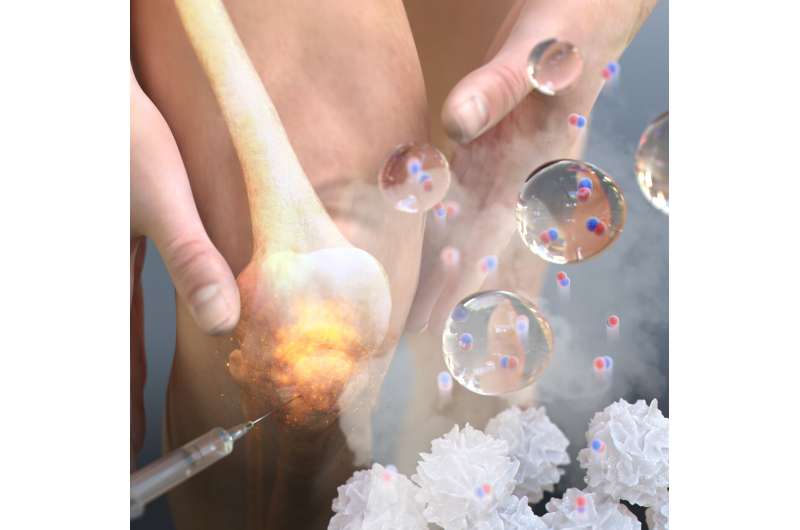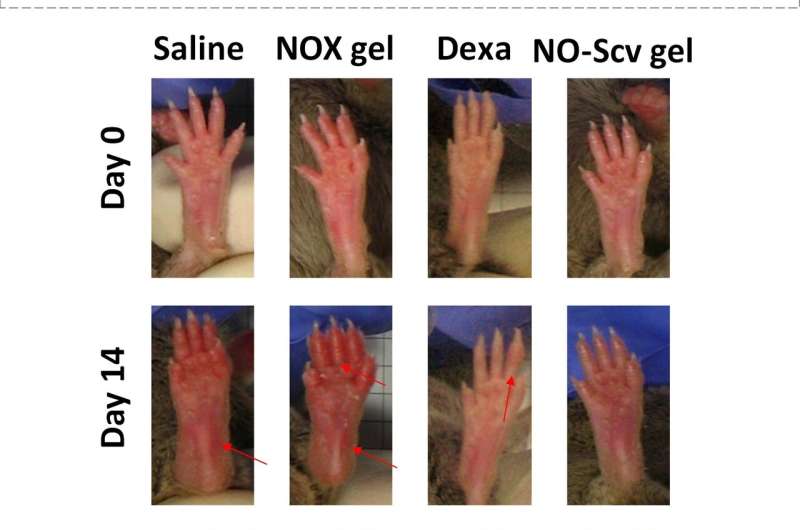Nitric oxide-scavenging hydrogel developed for rheumatoid arthritis treatment

Nitric oxide (NO) prevents high blood pressure and artery plaque build-up in our body. However, its duplicity is revealed when it causes serious inflammatory disease such as systemic lupus erythematosus, Crohn's disease, and rheumatoid arthritis.
The research team of POSTECH has suggested a new strategy for treating rheumatoid arthritis and has attracted increasing attention in this field.
The research team consisted of Prof. Won Jong Kim, Jiwon Yeo and Dr. Yeong Mi Lee of Chemistry Department utilized a NO-cleavable-crosslinker that reacts to NO, and developed a NO-scavenging nano-sized hydrogel (NO-Scv gel). They had previously performed an animal test successfully and confirmed better therapeutic effect than with current drugs.
Their new findings are published in the online publication of Nano Letters which is the international journal in nanoscience. This achievement was advanced from their previous development of NO-responsive hydrogels. Having demonstrated its excellent therapeutic effect, further clinical research may be expected.
Rheumatoid arthritis occurs when NO is overproduced in the body. Prof. Kim and his team have consistently looked at new ways to treat this inflammatory disease by scavenging NO and reducing its concentration in the body's disease sites.

As a result, they successfully developed a NO-responsive macro-sized hydrogel by integrating NO-cleavable crosslinkers (NOCCL) in 2017. This time, they took their research one step further, upgrading it to the current formula, NO-scavenging nano-sized hydrogel (NO-Scv gel) which consumes NO through reacting with NO.
This hydrogel is prepared by polymerization between acrylamide and NOCCL. It is different from the former drug, which suppresses NO by interaction between genes and enzymes, in that it is directly involved in scavenging NO and minimizes side effects. Also, it has a greater advantage in that it can be applied not only to treat rheumatoid arthritis but also to other NO-mediated inflammatory diseases.
The animal test with a mouse proved that this hydrogel is better than dexamethasone, a commercial drug, in suppressing the onset of rheumatoid arthritis effectively.
Prof. Kim who led the research commented, "The drugs that have been used for suppressing NO affect biomolecules in the body directly, and this brings various side effects such as insulin resistance and cardiovascular disease. But this nano-sized hydrogel has demonstrated many meaningful results: that it is more effective in treating rheumatoid arthritis by scavenging NO directly, and has decreased the possibility of the side effects caused by the current drugs that we use today."
More information: Jiwon Yeo et al, Nitric Oxide-Scavenging Nanogel for Treating Rheumatoid Arthritis, Nano Letters (2019). DOI: 10.1021/acs.nanolett.9b00496
Journal information: Nano Letters
Provided by Pohang University of Science & Technology (POSTECH)



















